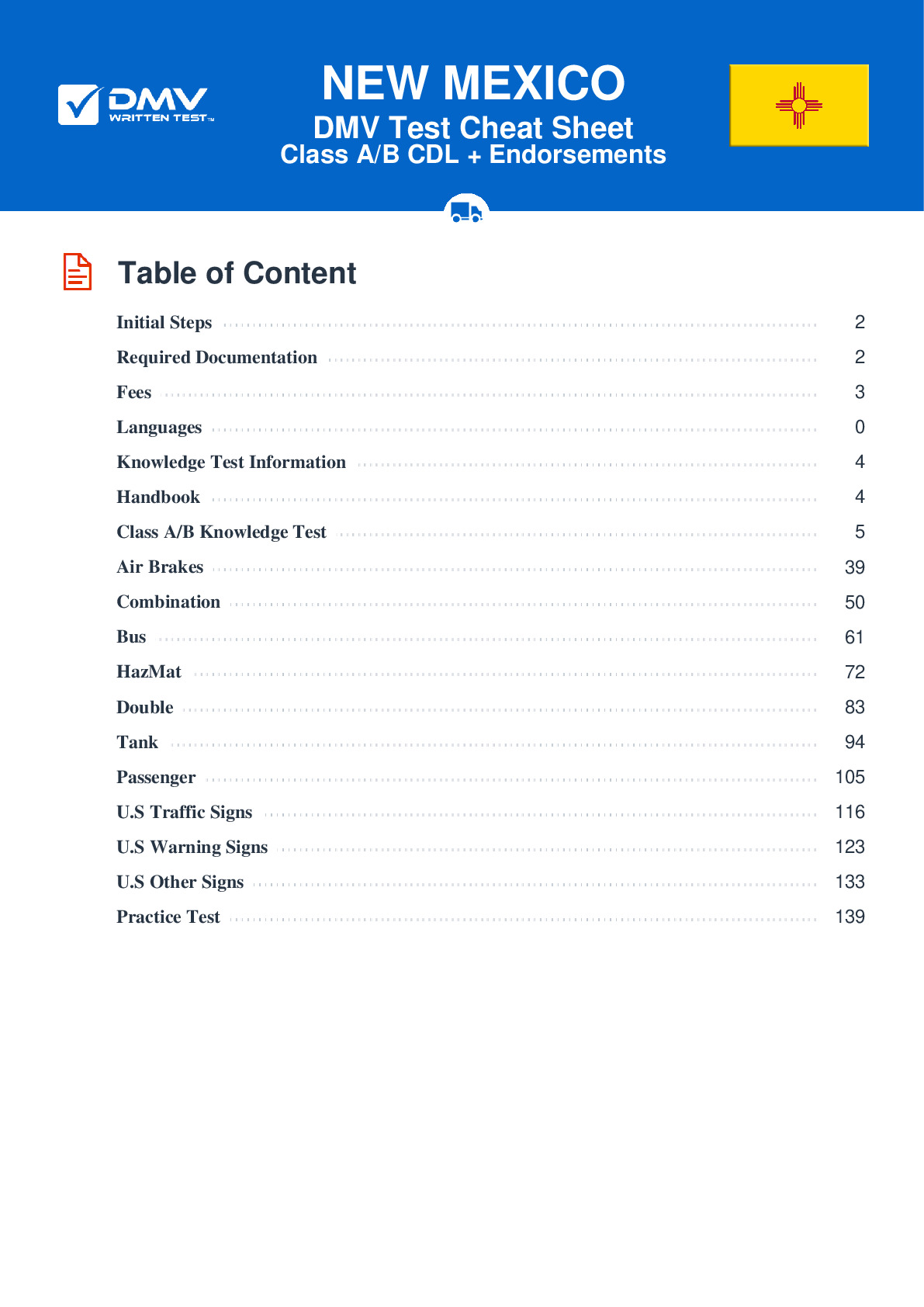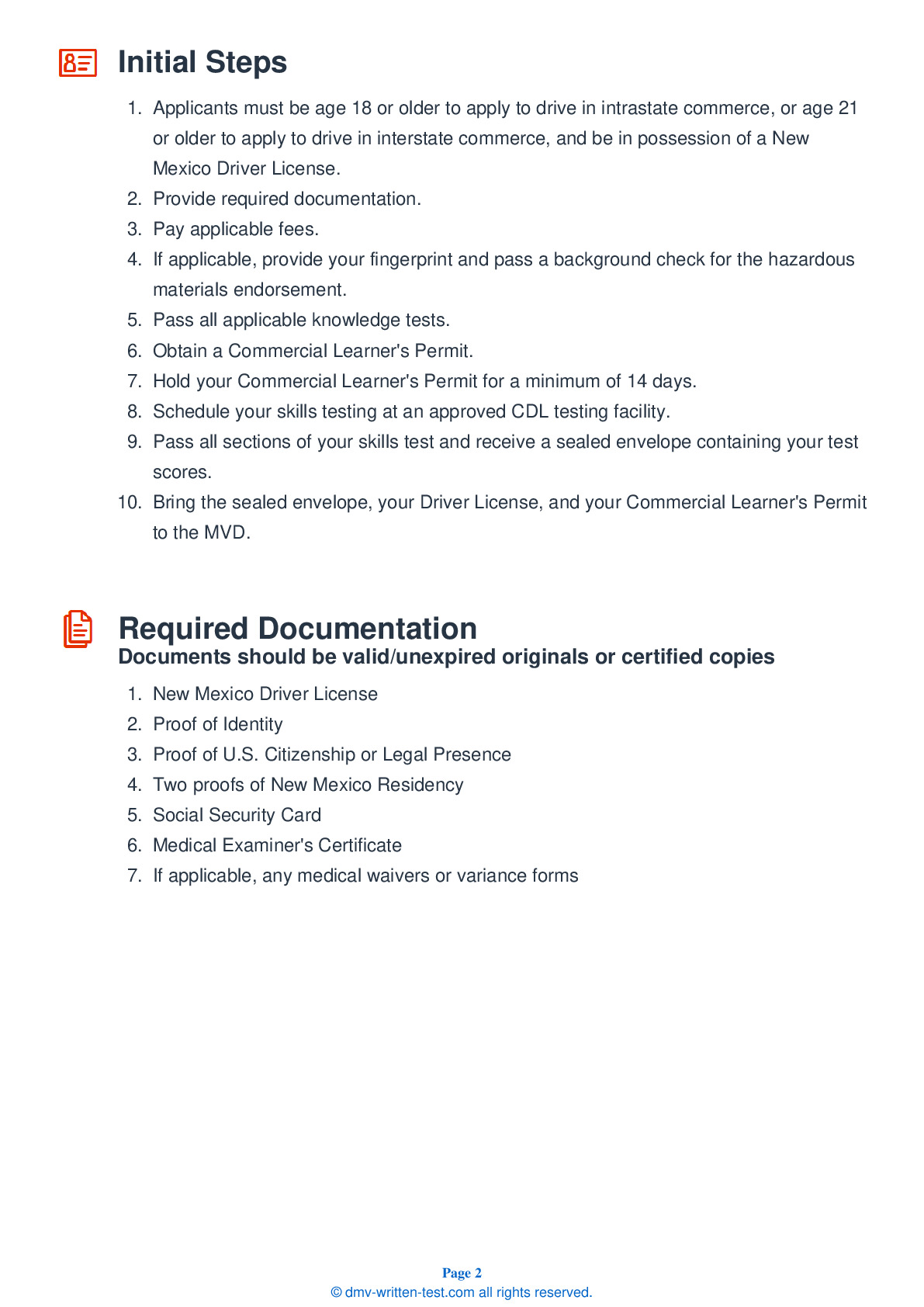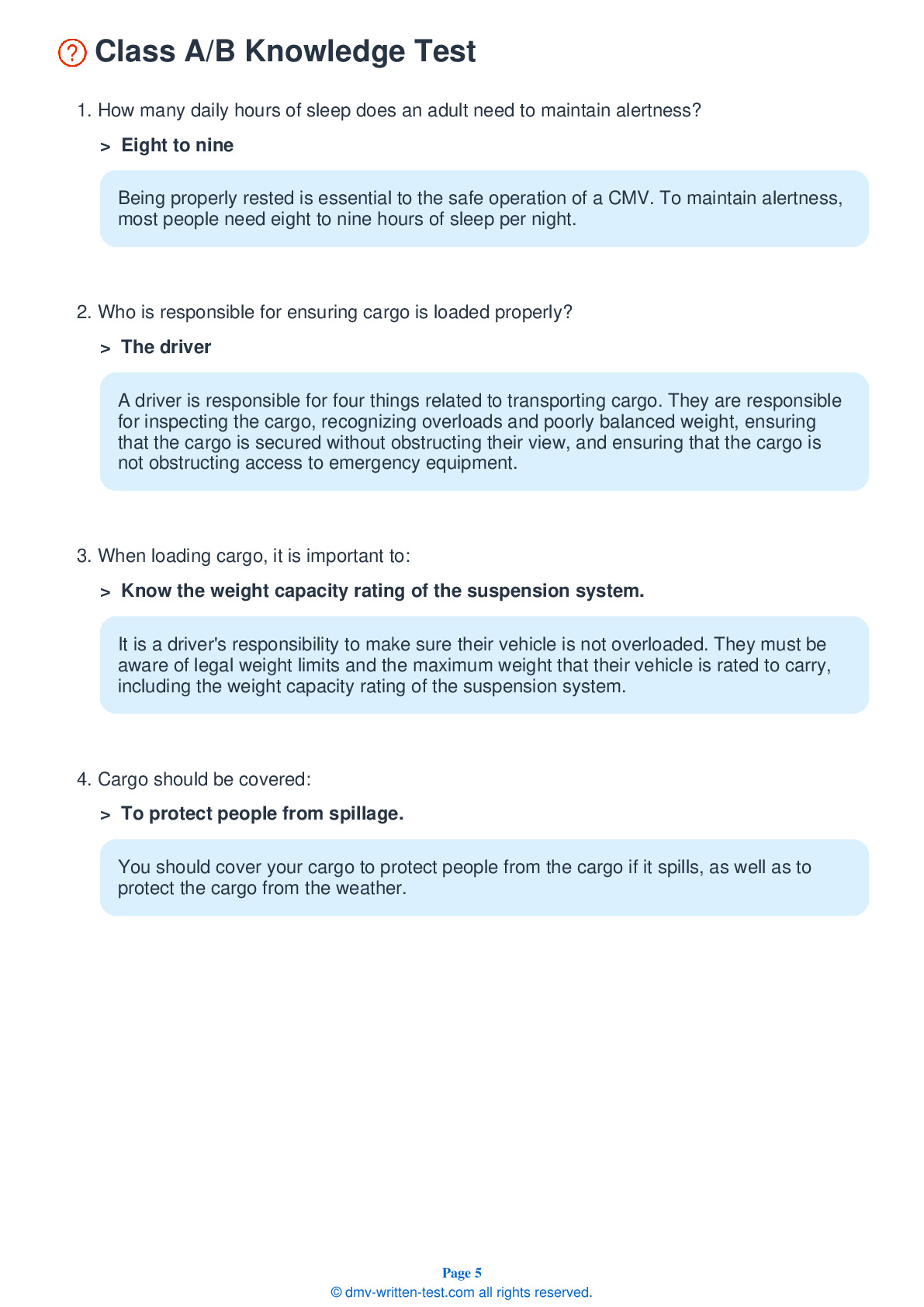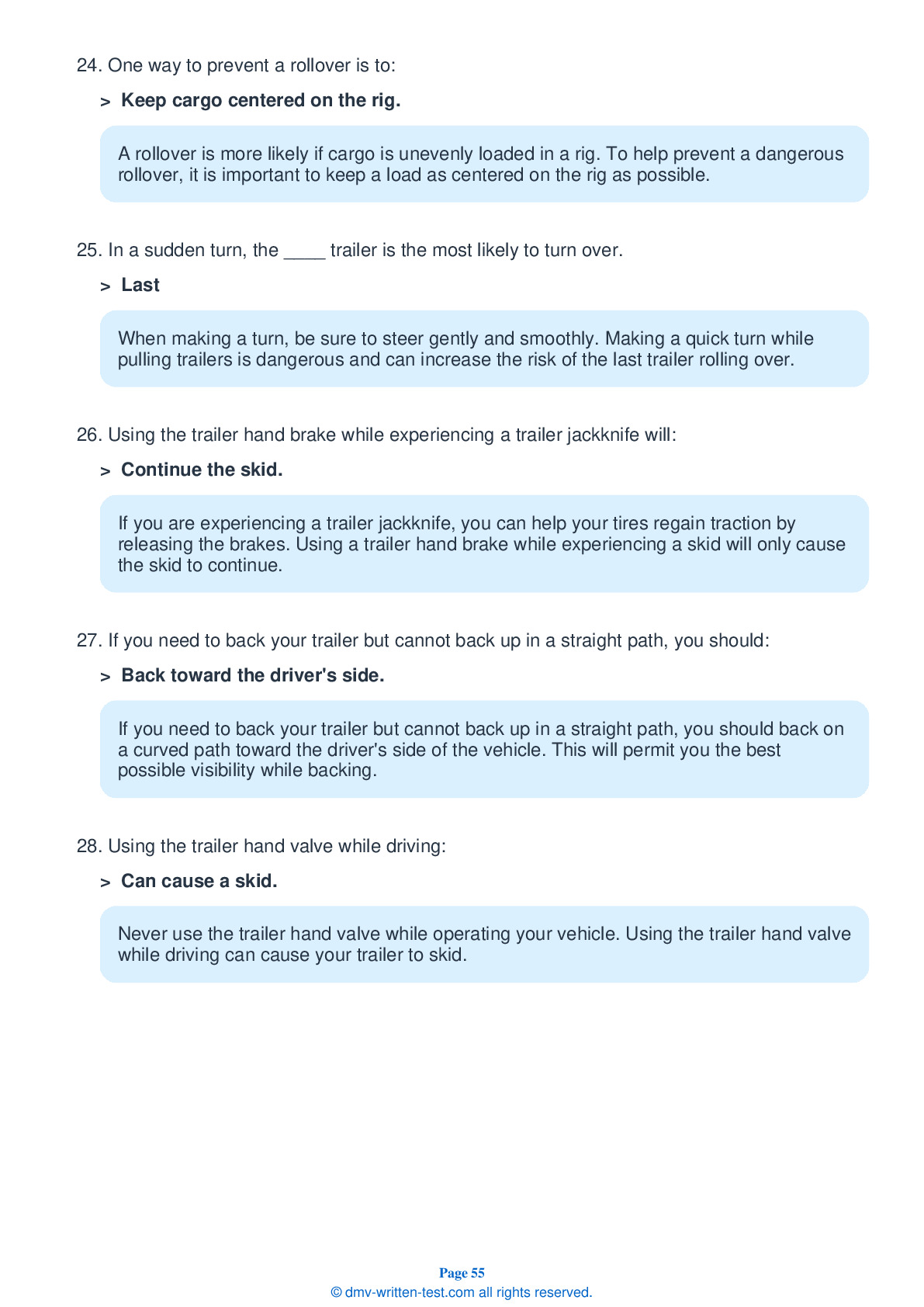Knowledge Test Class A
This license is required for driving any legal combination of vehicles, with a gross combination weight rating of 26,001 pounds or more, provided the GVWR of a trailer exceeds 10,000 pounds To receive this license, applicants must pass a 50-question test. To pass, applicants must answer 40 questions correctly. Each question has three possible answer choices. Test questions come from the New Mexico Commercial Driver License Manual. Questions come from chapters covering: Introduction, Driving Safely, Transporting Cargo Safely, Air Brakes (if applicable), Combination, Doubles and Hazardous Materials. Endorsements that may be used with a Class A CDL are: Hazardous materials, Tank, Passenger, HazMat and Tank, Air Brakes and School bus.
Number of Question
Passing Score
1. Mirrors should be used:
Explanation
When driving, you should frequently check the mirrors on both sides of your vehicle.
2. Too much air pressure in a tire:
Explanation
Tires should never have too much air pressure. Be sure to check your tires' air pressure with a gauge during inspections.
3. Emergency brakes:
Explanation
All trucks, truck tractors, and buses must be equipped with emergency brakes and parking brakes.
4. Dry bulk tanks:
Explanation
Dry bulk tanks require special care to be driven, both because they have high centers of gravity and because the weight of the load can shift in transit.
5. If the low air pressure warning signal comes on, you should:
Explanation
If the low air pressure warning signal comes on while you are driving a vehicle with air brakes, you should immediately bring the vehicle to a safe stop while you are still able to control the brakes. Inspect and repair the brakes as soon as possible.
6. If you are braking on dry pavement while traveling at 55 mph, how much distance will brake lag add to your overall stopping distance?
Explanation
The total stopping distance for vehicles equipped with air brakes is made up of four factors: perception distance, reaction distance, brake lag distance, and braking distance. When braking at a speed of 55 mph while driving on dry pavement, the brake lag can add around 32 feet to the vehicle's total stopping distance.
7. How do ice cream trucks become hazardous to other drivers?
Explanation
Ice cream trucks can create hazardous conditions for other drivers because they attract children. Children often do not notice or pay attention to other vehicles on the roadway when running to or from ice cream trucks.
Frequently Asked Questions
A Class A CDL (Commercial Driver's License) in New Mexico is a type of license that allows a driver to operate a combination of vehicles with a total weight of 26,001 pounds or more. This can include vehicles such as tractor-trailers, tanker trucks, and flatbed trucks.
To obtain a Class A CDL in New Mexico, you must first pass a written knowledge test and a driving skills test. You must also meet certain medical and residency requirements, have a valid driver's license, and pass a background check.
Once you have your Class A CDL, you may need to obtain endorsements for specific types of vehicles or cargo that you will be transporting. These endorsements may include hazardous materials, tankers, doubles/triples, or passenger vehicles.
It's important to note that operating a commercial vehicle without the proper license can result in fines and other penalties.
To obtain a Class A CDL in New Mexico, you must first pass a written knowledge test and a driving skills test. You must also meet certain medical and residency requirements, have a valid driver's license, and pass a background check.
Once you have your Class A CDL, you may need to obtain endorsements for specific types of vehicles or cargo that you will be transporting. These endorsements may include hazardous materials, tankers, doubles/triples, or passenger vehicles.
It's important to note that operating a commercial vehicle without the proper license can result in fines and other penalties.
With a Class A CDL license in New Mexico, you can operate combination vehicles with a total weight of 26,001 pounds or more. This can include:
1. Tractor-trailers: A combination of a truck tractor and one or more trailers or semi-trailers.
2. Double and triple trailers: A combination of two or three trailers or semi-trailers.
3. Tanker vehicles: Vehicles designed to transport liquids or gases, such as gasoline, milk, or propane.
4. Livestock carriers: Vehicles designed to transport live animals.
5. Flatbed trucks: Trucks with an open flatbed for hauling large items.
6. Dump trucks: Trucks designed to haul loose materials, such as dirt and gravel.
7. Heavy haulers: Vehicles designed to carry oversized loads.
It's important to note that specific endorsements may be required for certain types of vehicles or cargo, such as hazardous materials or passenger vehicles.
1. Tractor-trailers: A combination of a truck tractor and one or more trailers or semi-trailers.
2. Double and triple trailers: A combination of two or three trailers or semi-trailers.
3. Tanker vehicles: Vehicles designed to transport liquids or gases, such as gasoline, milk, or propane.
4. Livestock carriers: Vehicles designed to transport live animals.
5. Flatbed trucks: Trucks with an open flatbed for hauling large items.
6. Dump trucks: Trucks designed to haul loose materials, such as dirt and gravel.
7. Heavy haulers: Vehicles designed to carry oversized loads.
It's important to note that specific endorsements may be required for certain types of vehicles or cargo, such as hazardous materials or passenger vehicles.
To obtain a Class A CDL license in New Mexico, you must meet the following requirements:
1. Age: You must be at least 18 years old to obtain a Class A CDL, but you cannot operate a commercial vehicle across state lines until you are 21 years old.
2. Residency: You must be a resident of New Mexico or have proof of legal presence in the United States.
3. Medical requirements: You must pass a medical examination and obtain a medical examiner's certificate.
4. Driver's license: You must have a valid driver's license.
5. Knowledge test: You must pass a written knowledge test covering general commercial driving topics, such as safety, vehicle inspection, and road rules.
6. Skills test: You must pass a skills test that includes a pre-trip inspection, basic vehicle control, and on-road driving.
7. Background check: You must pass a background check that includes driving records and criminal history.
Once you have met these requirements and obtained your Class A CDL license, you may need to obtain additional endorsements for specific types of vehicles or cargo that you will be transporting. These endorsements may include hazardous materials, tanker vehicles, doubles/triples, or passenger vehicles.
1. Age: You must be at least 18 years old to obtain a Class A CDL, but you cannot operate a commercial vehicle across state lines until you are 21 years old.
2. Residency: You must be a resident of New Mexico or have proof of legal presence in the United States.
3. Medical requirements: You must pass a medical examination and obtain a medical examiner's certificate.
4. Driver's license: You must have a valid driver's license.
5. Knowledge test: You must pass a written knowledge test covering general commercial driving topics, such as safety, vehicle inspection, and road rules.
6. Skills test: You must pass a skills test that includes a pre-trip inspection, basic vehicle control, and on-road driving.
7. Background check: You must pass a background check that includes driving records and criminal history.
Once you have met these requirements and obtained your Class A CDL license, you may need to obtain additional endorsements for specific types of vehicles or cargo that you will be transporting. These endorsements may include hazardous materials, tanker vehicles, doubles/triples, or passenger vehicles.
In New Mexico, the minimum age requirement for a Class A CDL license is 18 years old. However, drivers who are under 21 years old are restricted from operating a commercial motor vehicle for interstate purposes, meaning they cannot transport goods or passengers across state lines.
Drivers who are 21 years old or older may operate a commercial motor vehicle across state lines as long as they meet the other federal and state requirements for obtaining a CDL. It's important to note that some employers may have their own age requirements for certain types of commercial driving jobs.
Drivers who are 21 years old or older may operate a commercial motor vehicle across state lines as long as they meet the other federal and state requirements for obtaining a CDL. It's important to note that some employers may have their own age requirements for certain types of commercial driving jobs.
Yes, depending on the type of vehicle and cargo you will be transporting, you may need to obtain additional endorsements to your Class A CDL license.
Here are the common endorsements for a Class A CDL license:
1. Hazmat endorsement: Required if you plan to transport hazardous materials.
2. Tanker endorsement: Required if you plan to transport liquids or gases in bulk.
3. Doubles/Triples endorsement: Required if you plan to haul double or triple trailers.
4. Passenger endorsement: Required if you plan to transport passengers for hire.
To obtain an endorsement, you must pass a written knowledge test and, in some cases, a skills test. Some endorsements require additional background checks or other requirements. It's important to note that endorsements may have different age requirements and fees than the base CDL license.
Here are the common endorsements for a Class A CDL license:
1. Hazmat endorsement: Required if you plan to transport hazardous materials.
2. Tanker endorsement: Required if you plan to transport liquids or gases in bulk.
3. Doubles/Triples endorsement: Required if you plan to haul double or triple trailers.
4. Passenger endorsement: Required if you plan to transport passengers for hire.
To obtain an endorsement, you must pass a written knowledge test and, in some cases, a skills test. Some endorsements require additional background checks or other requirements. It's important to note that endorsements may have different age requirements and fees than the base CDL license.
The Class A CDL skills test is a two-part test that consists of a pre-trip inspection test and a driving skills test.
1. Pre-Trip Inspection Test: During this part of the test, you will be asked to demonstrate your knowledge of the commercial vehicle's components and safety features. You will be asked to visually inspect the vehicle and identify any potential safety hazards or mechanical issues.
2. Driving Skills Test: During this part of the test, you will be asked to demonstrate your driving skills in a commercial vehicle. You will be tested on your ability to safely handle the vehicle, including backing up, turning, and parking. You will also be tested on your ability to perform basic maneuvers, such as shifting gears and using turn signals.
The driving skills test is typically conducted on a closed course or in a controlled environment on public roads under the supervision of an examiner. The examiner will score your performance based on a set of criteria defined by the Federal Motor Carrier Safety Administration (FMCSA).
It's important to note that the Class A CDL skills test is a rigorous exam that requires significant preparation and practice. You should consider enrolling in a CDL training program to help you prepare for the exam and gain the necessary skills and knowledge to become a safe and competent commercial driver.
1. Pre-Trip Inspection Test: During this part of the test, you will be asked to demonstrate your knowledge of the commercial vehicle's components and safety features. You will be asked to visually inspect the vehicle and identify any potential safety hazards or mechanical issues.
2. Driving Skills Test: During this part of the test, you will be asked to demonstrate your driving skills in a commercial vehicle. You will be tested on your ability to safely handle the vehicle, including backing up, turning, and parking. You will also be tested on your ability to perform basic maneuvers, such as shifting gears and using turn signals.
The driving skills test is typically conducted on a closed course or in a controlled environment on public roads under the supervision of an examiner. The examiner will score your performance based on a set of criteria defined by the Federal Motor Carrier Safety Administration (FMCSA).
It's important to note that the Class A CDL skills test is a rigorous exam that requires significant preparation and practice. You should consider enrolling in a CDL training program to help you prepare for the exam and gain the necessary skills and knowledge to become a safe and competent commercial driver.
Yes, there are some restrictions and limitations for drivers with a Class A CDL license. Here are a few examples:
1. Endorsement Restrictions: If you have a Class A CDL with specific endorsements, you may be limited to driving certain types of commercial vehicles or carrying certain types of cargo. For example, if you have a hazmat endorsement, you may be restricted from driving certain routes or carrying certain hazardous materials.
2. Vehicle Restrictions: Depending on the weight and size of the vehicle, some Class A CDL drivers may be restricted from driving certain types of commercial vehicles. For example, if you only have experience driving tractor-trailers, you may be restricted from driving larger commercial vehicles like buses or tankers.
3. Medical Restrictions: All commercial drivers must pass a medical exam to obtain and maintain their CDL license. If a driver has certain medical conditions or takes certain medications, they may be restricted from driving commercial vehicles.
4. Time Restrictions: Some states have restrictions on the hours of operation for commercial drivers. For example, in New Mexico, commercial drivers are limited to 11 hours of driving time and 14 hours of on-duty time per day.
It's important to be aware of any restrictions or limitations that apply to your Class A CDL license to avoid violations that could result in fines or even the loss of your license.
1. Endorsement Restrictions: If you have a Class A CDL with specific endorsements, you may be limited to driving certain types of commercial vehicles or carrying certain types of cargo. For example, if you have a hazmat endorsement, you may be restricted from driving certain routes or carrying certain hazardous materials.
2. Vehicle Restrictions: Depending on the weight and size of the vehicle, some Class A CDL drivers may be restricted from driving certain types of commercial vehicles. For example, if you only have experience driving tractor-trailers, you may be restricted from driving larger commercial vehicles like buses or tankers.
3. Medical Restrictions: All commercial drivers must pass a medical exam to obtain and maintain their CDL license. If a driver has certain medical conditions or takes certain medications, they may be restricted from driving commercial vehicles.
4. Time Restrictions: Some states have restrictions on the hours of operation for commercial drivers. For example, in New Mexico, commercial drivers are limited to 11 hours of driving time and 14 hours of on-duty time per day.
It's important to be aware of any restrictions or limitations that apply to your Class A CDL license to avoid violations that could result in fines or even the loss of your license.
Yes, in New Mexico, you can take the Class A CDL written test in a language other than English. The New Mexico Motor Vehicle Division (MVD) offers the written test in several languages, including Spanish, Chinese, and Vietnamese.
However, it's important to note that you will still need to be able to read and understand English signs and signals on the road. Additionally, the skills test that you will need to take to obtain your Class A CDL license is typically conducted in English.
If you need assistance with understanding the English language, you may be able to bring a translator with you to the test. However, the translator must be approved by the MVD and may not be a family member or friend.
Be sure to check with your local MVD office for specific requirements and procedures for taking the Class A CDL written test in a language other than English.
However, it's important to note that you will still need to be able to read and understand English signs and signals on the road. Additionally, the skills test that you will need to take to obtain your Class A CDL license is typically conducted in English.
If you need assistance with understanding the English language, you may be able to bring a translator with you to the test. However, the translator must be approved by the MVD and may not be a family member or friend.
Be sure to check with your local MVD office for specific requirements and procedures for taking the Class A CDL written test in a language other than English.
Yes, if you have a disability that affects your ability to take the Class A CDL written test, you can request accommodations. The New Mexico Motor Vehicle Division (MVD) provides reasonable accommodations for individuals with disabilities, in accordance with the Americans with Disabilities Act (ADA).
To request accommodations for the written test, you will need to fill out an Application for Reasonable Accommodations and submit it to the MVD. The application requires you to provide documentation of your disability and the specific accommodations that you are requesting.
The MVD will review your application and determine if the requested accommodations are reasonable and necessary. Reasonable accommodations may include things like extended testing time, a reader, or a sign language interpreter.
It's important to note that you will need to submit your application and documentation well in advance of your scheduled test date to allow time for review and approval of your request.
For more information on requesting accommodations for the Class A CDL written test, contact your local MVD office or visit the New Mexico MVD website.
To request accommodations for the written test, you will need to fill out an Application for Reasonable Accommodations and submit it to the MVD. The application requires you to provide documentation of your disability and the specific accommodations that you are requesting.
The MVD will review your application and determine if the requested accommodations are reasonable and necessary. Reasonable accommodations may include things like extended testing time, a reader, or a sign language interpreter.
It's important to note that you will need to submit your application and documentation well in advance of your scheduled test date to allow time for review and approval of your request.
For more information on requesting accommodations for the Class A CDL written test, contact your local MVD office or visit the New Mexico MVD website.
If you fail the Class A CDL written test, you are allowed to retake the test. However, there may be a waiting period before you can take the test again.
In New Mexico, if you fail the written test, you must wait at least one day before you can retake it. If you fail the test three times, you will need to wait at least 30 days before taking it again.
It's important to note that there may be additional fees associated with retaking the test. Be sure to check with your local Motor Vehicle Division (MVD) office for specific information on fees and waiting periods.
To prepare for the written test and increase your chances of passing, you can study the New Mexico CDL manual and take practice tests. Many resources are available online or through local driving schools.
If you continue to have difficulty passing the written test, you may want to consider getting additional help or tutoring to improve your knowledge and understanding of the material.
In New Mexico, if you fail the written test, you must wait at least one day before you can retake it. If you fail the test three times, you will need to wait at least 30 days before taking it again.
It's important to note that there may be additional fees associated with retaking the test. Be sure to check with your local Motor Vehicle Division (MVD) office for specific information on fees and waiting periods.
To prepare for the written test and increase your chances of passing, you can study the New Mexico CDL manual and take practice tests. Many resources are available online or through local driving schools.
If you continue to have difficulty passing the written test, you may want to consider getting additional help or tutoring to improve your knowledge and understanding of the material.




